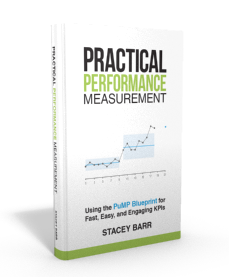Harvard Business Review: 5 Ways to Measure Business Performance
by Stacey Barr |You’ll get better quality measures when you start to deliberately choose the best way to quantify your measures. It’s too easy to default to counts and percentages. Instead, learn these five basic quantification formulae so you can make better choices in the future.
TAKE ACTION:
Have you limited your measures and KPIs to counts and percentages? Check if these really are the most appropriate quantification formulae for your measures, and perhaps you’ll discover you can get much more meaning if you try something else.
Connect with Stacey
Haven’t found what you’re looking for? Want more information? Fill out the form below and I’ll get in touch with you as soon as possible.
Suite 117 Level 14,
167 Eagle Street,
Brisbane Qld 4000,
Australia
167 Eagle Street,
Brisbane Qld 4000,
Australia
Stacey Barr Pty Ltd
ACN: 129953635
Director: Stacey Barr
ACN: 129953635
Director: Stacey Barr




